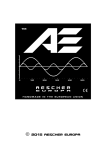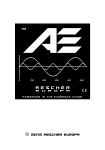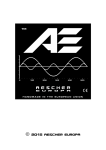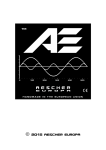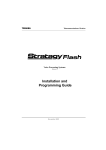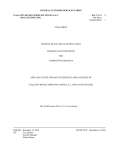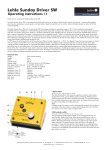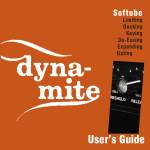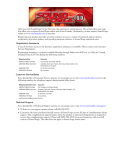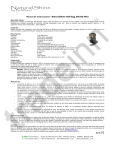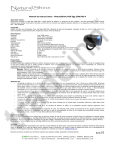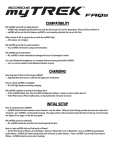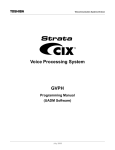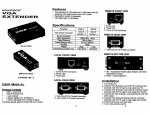Download user manual
Transcript
2015 AEScHER EUROPA V 3 - User Manual V Series 1 1.1 1.2 1.3 SET UP Overview Power Supply Functions 2 2.1 2.2 2.3 2.4 2.5 2.6 2.7 OPERATION Instrument Compatibility Handling String Mounting & Tracking String Driving Proximity Effects Onboard Effects Maintenance 1 SET UP 1.1 Overview The SRG V Series are a line of handheld, externally powered string resonators, based on nano scale SMDI architecture Available in monophonic and polyphonic models. The ● ● SRG V3 package includes : V 3 Handheld Articulated Monophonic Universal Resonator ● AMX Power Supply Armband AMX-10 10 Volt Flatcell ● PS-2 PS 2 Power Cable The V3 features highly inductive, low resonant frequency sensor and driver coils - optimised for bass instruments, directly wound on neodymium core magnets. The compact design of the V3 measuring only 10 x 45 x 45 mm with a mass of only 21 gram, is only possible due to high flux density neodymium core magnets and SMDI integration. The V3 also features protruding FANG rails for accurate string tracking and an ultra bright - deep blue LED power indicator. SET UP > After unpacking the box, open and fasten the armband over the wrist of the operating arm - adjusting the tightness until the armband is as tight as possible within comfort limits. Any looseness in the armband may cause the power supply to impact with the strings. Connect the power supply cable first to the AMX-10 Flatcell, and then to the DC connector on the SRG. Orientate the power supply connector in the DC socket of the V3 outwards away from the strings – as shown in the following illustration. The armband should be positioned so that the power cable does not have any slack which could impact with the strings. The blue LED power indicator will light up instantly when the power supply cable is firmly connected. A flickering LED means that the cable is Not firmly connected. The V3 is fully operational the moment the blue LED is on. 1.2 Power Supply The V Series includes a DC connector for an external power supply. With the exception of the E Series - All SRGs are externally powered, and therefore not design limited by internal 9 volt batteries. The unconstrained design also allows for future advances in energy storage technology. The AMX Power Supply Armband and Power Supply Belt Pack both supply 10 V / 700 mAh to the SRG via a DC power supply cable. The AMX-10 is a 10 Volt Alkaline-Manganese primary cell, and is safely disposable. Under No Circumstances is the AMX-10 to be recharged or dismantled. The storage life of the AMX-10 is 5 years. Only the AMX-10 can supply full current to the V3, although the SRG can operate at a lower power output on a 9 Volt supply. The optional AMX-10R is a rechargeable NiMH version of the AMX-10 Flatcell, for use only with the AMX-10R Flatcell charger. The optional AMX-9 Battery Adapter allows connection of a standard 9 Volt battery and fits within the Flatcell holder of the AMX Power Supply Armband. The AMX-9 Battery Adapter is designed for situations where a fully charged AMX-10 is not readily available. 1.3 Functions The V3 includes 2 onboard trigger effects: • HPF (high pass filter) • LPF (low pass filter) The forward right side trigger activates LPF Mode, attenuating high frequencies by 26 dB, with the effect of a bass boost, which produces a cello effect on bass instruments. The backward right side trigger activates HPF Mode, attenuating low frequencies and enhancing harmonics. Rapid triggering or alternated triggering produces some very interesting special effects available only to the SRG. 2 OPERATION 2.1 Instrument Compatibility The SRG functions on any stringed instrument with ferromagnetic strings, including plain steel strings and steel core strings. The V3 is equally compatible with light gauge string instruments such as guitar, and heavy gauge bass string instruments. The tracking rails on the V3 are optimised for bass instruments, accomodating bass string spacings of 16 - 22 mm on the outer rails, as well as light gauge string instruments with string spacings of 8 – 12 mm on the inner rails. The unique "Fang" rail design allows more stable and accurate string mounting and tracking. A minimum instrument pickup to string clearance of 4 mm is recommended. The SRG is also capable of driving Acoustic Steel String Instruments without electromagnetic transducers , although the tonal effects are less audible and transducer proximity effects are unavailable. Bowed String Instruments such as Cello or Contrabass require a V4 resonator, and solid steel core strings, - helical core strings do not contain enough ferro-magnetic mass to be inductively driven. 2.2 Handling The SRG V Series is designed to be handheld between the thumb and ring finger with the index and middle fingers free to operate the triggers, with the LED facing towards the nut of the instrument. The V3 is securely tethered to the cable of the AMX Armband, and therefore will not crash to the stage floor if the grip on the SRG is lost during operation. 2.3 String Mounting & Tracking Place the guide rails on the 2 support strings, with the support strings on either the inside or outside of the "Fangs" depending on the string spacing of the instrument. The SRG should rest absolutely level on the guide strings, and never tilted to one side. It's important to get a feel for the optimal positioning of the SRG, through persistent practice. Proper use of a cello bow is not learned in a day, and neither is the proper use of an SRG – both take practice! 2.4 String Driving String driving (resonance) will initiate immediately after holding the SRG steady and level on the support strings. Any deviation from top dead centre above and parallel to the driven string will result in various effects, the most obvious being fade in / fade out, and reverse envelope effect. All positional effects are a result of deviation from parallel top dead centre above the driven string. The best path to finding desirable effects is through constant experimentation. 2.5 Input Transducer Effects Various Legato and Staccato effects are possible through the proximity and forward / backward angular relationship between the driver and the magnetic core of the input transducer (pickup) on the instrument. Most useful effects depend on this distance and angular relationship Provoking the input transducer in every conceivable manner will result in the discovery of more than a few useful effects. Note* The use of a headphone amp during the lower end of the learning curve is highly recommended. Extraordinary efforts have been made in molesting the guitar to badly imitate the sounds of other instruments. The best advice this manual can offer, is to use "other instruments" rather than trying to imitate them, and discover "New" sounds with the SRG. 2.6 Onboard Effects The V3 has 3 Operating Modes : • Normal Mode • LPF Mode • HPF Mode Normal Mode is the default state with all switches open (untriggered). The forward right side trigger activates LPF Mode, attenuating high frequencies, with the effect of a bass boost, which produces a cello effect on bass instruments. The backward right side trigger activates HPF Mode, attenuating low frequencies and enhancing harmonics. Rapid triggering or alternated triggering produces some very interesting special effects available only to the SRG. 2.7 Maintenance If possible - always store the SRG in a dry, dust-free environment at room temperature (15 - 20° C). Always remember to disconnect the Power Supply when not in use. There is no OFF switch on the V Series SRG or power supply, OFF = Disconnected Power Cable Clean the SRG using a soft cotton cloth or t-shirt soaked in warm water, tight places may be cleaned using a cotton bud. To remove minor scratches – the SRG may be polished using 1000 grit wet & dry sandpaper and rubbed with vegetable oil. Never attempt to clean any part of the SRG with alcohol, acetone, ammonia, or any household cleaner! TECHNICAL SPECIFICATIONS SRG MODEL V 3 Supply Voltage Power Output Driver Resonant Frequency Sensor Resonant Frequency Core Magnets Quiescent Current Drain Operating Current Drain Voltage Gain LPF Attenuation THD Storage Temperature Operating Temperature Width Length Height Mass 10 V 500 mW 2300 Hz 2300 Hz Neodymium 8 mA 55 mA 46 dB 26 dB 0.2% 15° - 25° C 0° - 35° C 44 mm 44 mm 10 mm 21 g
















